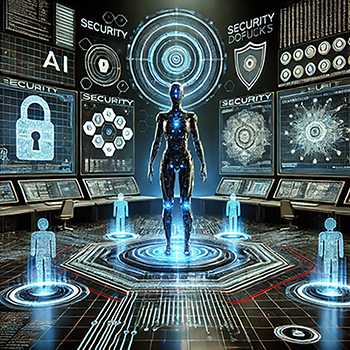As the digital landscape evolves, so too do the threats that target it. Cybercriminals are becoming more sophisticated, utilizing advanced tactics to breach systems, steal data, and disrupt services. To combat these emerging threats, artificial intelligence (AI) is stepping up as a critical tool in the fight for cybersecurity. AI's ability to analyze vast amounts of data, recognize patterns, and respond in real time is transforming how we protect the digital world.
The Rising Threat Landscape
The digital world is under constant threat from a variety of cyberattacks, including malware, phishing, ransomware, and Distributed Denial of Service (DDoS) attacks. These threats not only target individuals but also aim at businesses, governments, and critical infrastructure. As these attacks grow in frequency and sophistication, traditional cybersecurity measures are struggling to keep up.
For example, phishing attacks—where attackers trick individuals into providing sensitive information—have evolved to bypass basic security measures. Similarly, ransomware attacks, which encrypt a victim’s data and demand payment for its release, are becoming more targeted and destructive. In this rapidly changing environment, the need for more advanced and adaptive cybersecurity solutions is evident.
The Role of AI in Cybersecurity
AI is proving to be a game-changer in the realm of cybersecurity. Its ability to process and analyze vast amounts of data in real time allows it to detect and respond to threats far more quickly and accurately than human analysts alone. AI-driven cybersecurity systems can identify patterns of malicious behavior, predict potential threats, and take preventive action, often before a human would even recognize the danger.
One of the primary ways AI enhances cybersecurity is through anomaly detection. Traditional security systems rely on predefined rules to identify threats. However, these systems can only detect known threats and often fail to recognize new, evolving tactics. AI, on the other hand, uses machine learning algorithms to learn from vast datasets, enabling it to identify deviations from normal behavior. For instance, if an AI system detects unusual login patterns, such as an attempt to access an account from an unfamiliar location or device, it can flag this activity as potentially malicious and take immediate action, such as locking the account or alerting security personnel.
AI in Action: Real-World Applications
AI is already being integrated into various cybersecurity tools and platforms to enhance protection across different sectors.
Threat Detection and Response: AI-powered security systems can analyze network traffic in real time, identifying and responding to threats such as malware or intrusions. By continuously learning from new data, these systems can adapt to emerging threats, providing a dynamic defense mechanism. For example, many antivirus programs now incorporate AI to detect previously unknown malware based on its behavior rather than relying solely on signature-based detection.
Phishing Prevention: AI can be employed to identify phishing emails by analyzing language patterns, sender behavior, and email metadata. Advanced AI systems can also simulate potential attacks to train employees, making them more aware of phishing tactics and reducing the likelihood of successful attacks.
User Authentication: Biometric authentication methods, such as facial recognition and fingerprint scanning, are becoming more prevalent, and AI plays a crucial role in enhancing their accuracy and security. AI algorithms can learn and adapt to slight changes in a user’s biometric data, such as aging or changes in lighting conditions, ensuring that authentication remains secure and reliable.
Automated Incident Response: In the event of a security breach, AI-driven systems can automatically respond by isolating affected systems, applying patches, and even conducting forensic analysis to determine the cause of the breach. This rapid response capability is crucial in minimizing damage and preventing further exploitation.
Challenges and Ethical Considerations
While AI offers significant benefits for cybersecurity, it is not without challenges. One concern is the potential for AI systems to be exploited by cybercriminals. Just as AI can be used to defend against attacks, it can also be used to create more sophisticated and targeted attacks. For example, attackers could use AI to develop more convincing phishing emails or to bypass security systems that rely on AI for threat detection.
Another challenge is the issue of false positives. AI systems, particularly those that are overly sensitive, can sometimes flag legitimate activities as threats, leading to unnecessary disruptions. This highlights the need for continuous monitoring and fine-tuning of AI systems to balance security with usability.
Ethical considerations also come into play, particularly regarding data privacy. AI systems often require access to vast amounts of data to function effectively, raising concerns about how this data is collected, stored, and used. Ensuring that AI-driven cybersecurity solutions comply with privacy regulations and respect user rights is essential.
The Future of AI in Cybersecurity
As cyber threats continue to evolve, the role of AI in cybersecurity will only become more critical. The future will likely see even greater integration of AI into all aspects of cybersecurity, from threat detection and response to user authentication and incident management. Moreover, the development of AI-driven cybersecurity solutions that can operate autonomously, without the need for human intervention, could revolutionize how we protect our digital world.
However, it is essential to approach the use of AI in cybersecurity with caution. Continuous research, ethical considerations, and collaboration between industry, governments, and academia will be necessary to ensure that AI is used responsibly and effectively.




Comments (0)